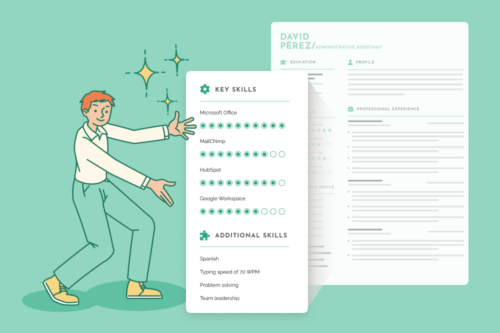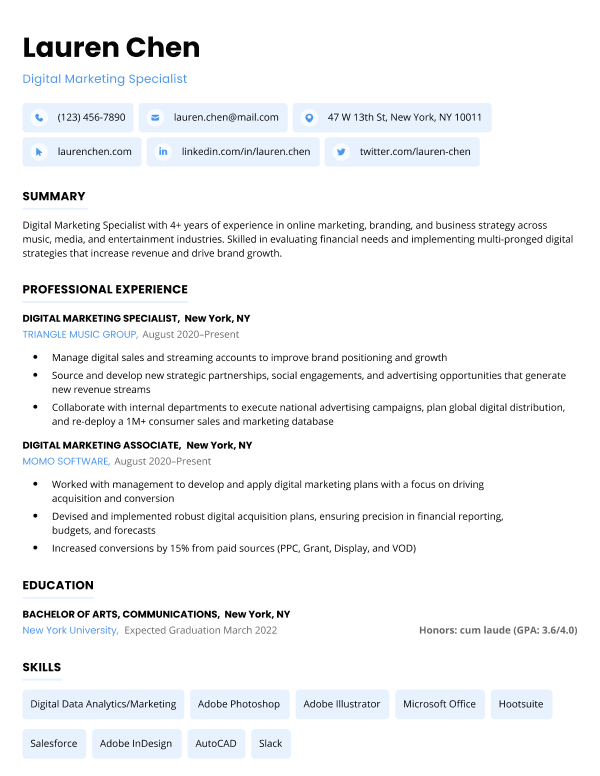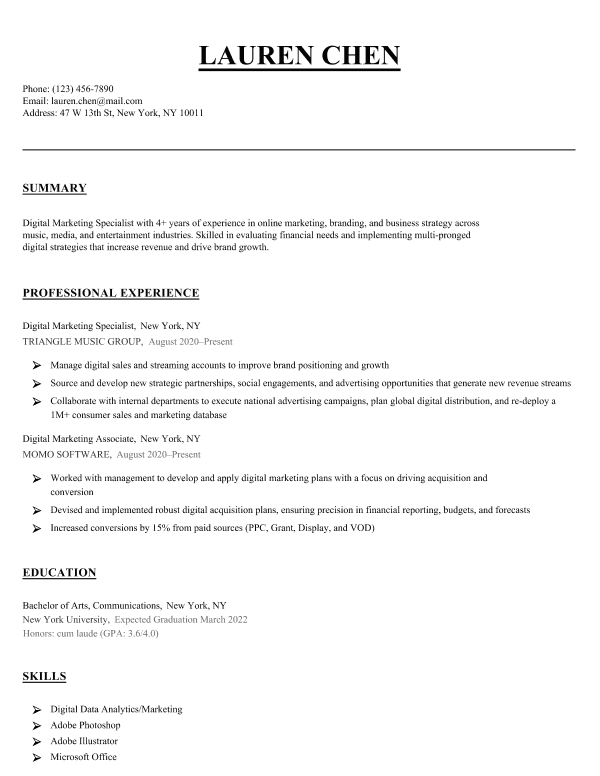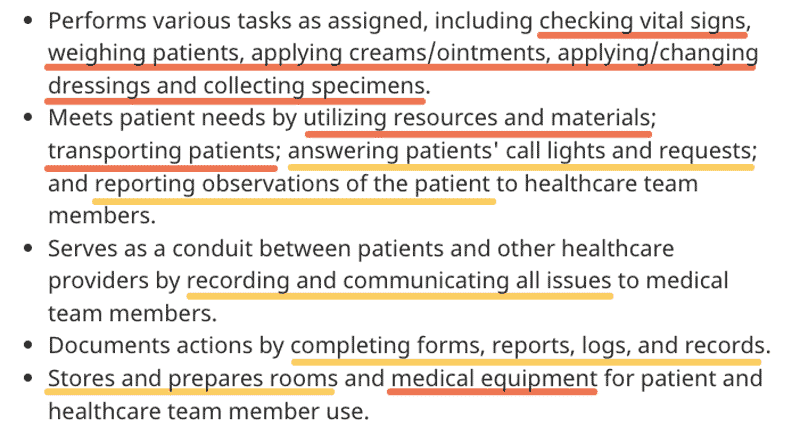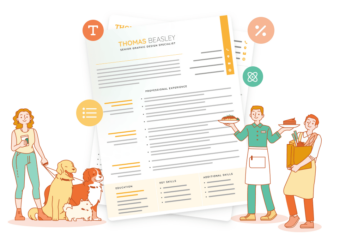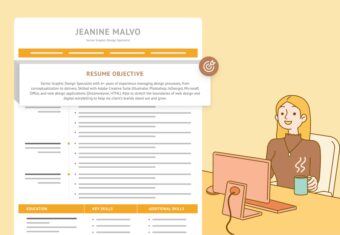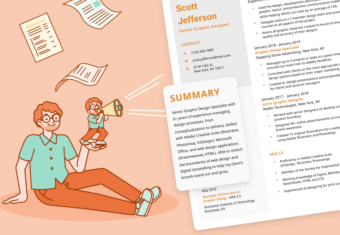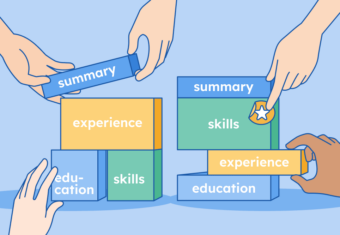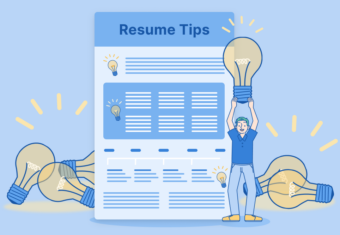In this article, we’ll share the three keys to writing an effective resume skills section: how to identify the best skills to include on your resume, where to put them, and what types of skills you should include.
How to find skills to put in your resume skills section
Follow these four steps, and choosing which skills make the cut will be straightforward.
Our free-to-use resume builder can make you a resume in as little as 5 minutes. Just pick the template you want, and our software will format everything for you.
1. Brainstorm your skills
You have your own distinct set of marketable skills. Making a list of your skills and then deciding which of these abilities are relevant to the job you want helps you create the best possible resume skills section.
Some work-related abilities are learned in school, others are mastered on the job, and sometimes they’re picked up through extracurricular activities or volunteer work. These types of skill are known as hard skills.
Soft skills relate to your personality, and you can list these skills on your resume to round out your skills section.
Write down every skill you possess in a Google Doc. Then, organize these skills into hard and soft skills. A combination of these skills should be put in the skills section of your resume to show employers you’re a well-rounded applicant.
2. Check the job ad
To create a job-winning resume skills section, list skills that are:
- relevant to the position
- mentioned in the job description
While job descriptions often explicitly mention skills that are required or preferred, job ads sometimes hint at desired skills as well.
Take this certified nursing assistant job listing, for instance. Yellow highlights denote soft skills; orange signals hard skills:
You can figure out what the hiring manager wants if you look close enough — particularly when it comes to desirable soft skills.
Check out these four examples:
- “Reporting observations of the patient” → Oral communication skills
- “Completing forms, reports, logs, and records” → Written communication skills
- “Prepare rooms” → Organizational skills
- “Answering patients’ … requests” → People skills
Some of your skills will match the ones on the job description, and others will be loosely related. So indicate how your skills can help you do the job by providing more detail in your work history section.
Depending on your industry, the number of hard and soft skills you list should differ. For instance, the best engineering skills include many technical skills, and technical skills are hard skills.
By contrast, if you’re a bartender, you need well-rounded interpersonal skills to deal with customers and colleagues. In this case, soft skills should feature in your resume skills section (except for the number of cocktails you know how to make — definitely display that hard skill).
3. Get more ideas for skills online
If you still need skills to fill up your resume’s skill section, here are some more sources for ideas:
- LinkedIn: Look at the LinkedIn page of employees working in similar roles as the job you’re applying for and check whether you have skills in common. If you do, use them on your resume.
- O*Net Online and similar sites: O*Net Online lets you view skills by occupation. Type a job into its search bar, and it shows you a list of skills to add to your resume.
- Other job ads (for similar roles): You can also look at job sites for similar roles and use skill keywords on your resume if they apply to you.
Additionally, if you want to save time, use a resume maker to fill out your skills section. Some resume builder software automatically pulls from a database to suggest relevant skills for your resume, saving you the effort of searching yourself.
To help your job search even more, add some job-relevant skills to your LinkedIn to help your profile stand out and show up in more searches.
4. Cut irrelevant skills
Now you’ve listed your skills and checked the job ad, decide which skills to put on your resume.
If you’re writing a bank teller resume, your time management skills and number skills should be emphasized.
However, if you’re writing a sports coach resume, you should instead focus on your sports certifications and teaching-related soft skills.
Once you’ve narrowed down your list to only skills related to your target job, you’re close to creating a good skills section.
Where to list skills on your resume
How many skills you end up putting on your resume depends on you. If you have an impressive number of job-relevant skills, spread them across your resume in places like your work experience section and resume introduction.
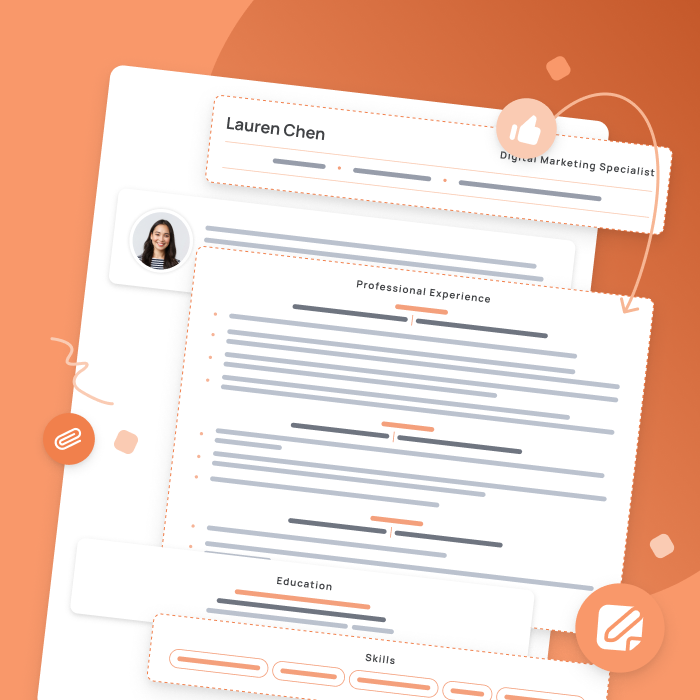
Read our guide to learn everything you need to know about how to make a resume that highlights your skills and impresses employers.
However, your resume’s skills section has limited space. Each skill you list should be related to the job you’re applying to, or else hiring managers will pass over your resume in favor of resumes more targeted to the position.
There are three types of skills sections you can use to highlight your key skills, and the type you choose determines how many skills you list:
- Additional skills section
- Technical skills section
- Relevant skills section
1. Additional skills section
An additional skills section (or skills section) is a standard component of a resume. Hiring managers expect to see at least a basic skills section, so you’ll see it on most resume templates you see online.
On a traditional chronological resume, your additional skills section should be small, while your work experience section should take up the most space.
Because you use your experience section to showcase your skills-based accomplishments on your resume, you can rely on your work history section to market your skills.
However, you should still put anywhere from three to eight or nine relevant skills in your skills section, and each one can help make a strong case as to why you’re the perfect hire.
Here’s an example of an additional skills section on a server resume:
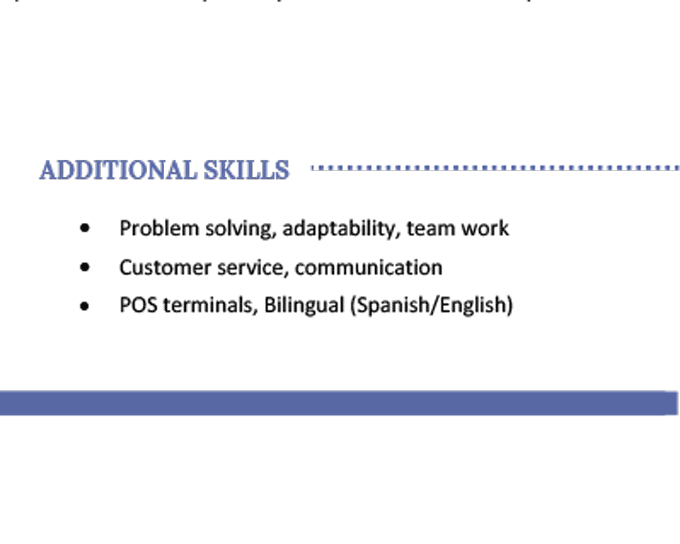
Best for:
- Entry-level positions
- Customer- or client-focused roles
- Career change resumes
2. Technical skills section
If your skill-set is equally as important to the job as your work experience, then having a dedicated technical skills section on your resume is an effective way to impress hiring managers by highlighting your technical prowess.
A technical skills section is paired with an additional skills section. Your technical skills section should be more prominent because hiring managers need to see you have these skills.
Check out this example technical skills section from a marketing resume:

Because marketing work demands a special set of abilities, this applicant includes their technical skills on their resume. They also break their marketing skills down into core areas like SEO and analytical tools, which organizes an extensive list into easy-to-read chunks of skills for the hiring manager.
Best for:
- Jobs that require many technical skills
- Applicants with many years of experience
- Candidates in the IT, medical, marketing, and research sectors
To showcase your skill set, use a skills bar or other visual element to highlight skill levels for your resume.
3. Relevant skills section
A relevant skills section is used on a functional resume or a skills-based resume, which you can use to downplay your work experience if you have extensive work history gaps or are transferring into a new industry.
Using a relevant skills section allows you to demonstrate how past achievements and work have helped you hone specific skills.
If you use a relevant skills section, it should be larger than your work experience section, as you can see on these resume samples:
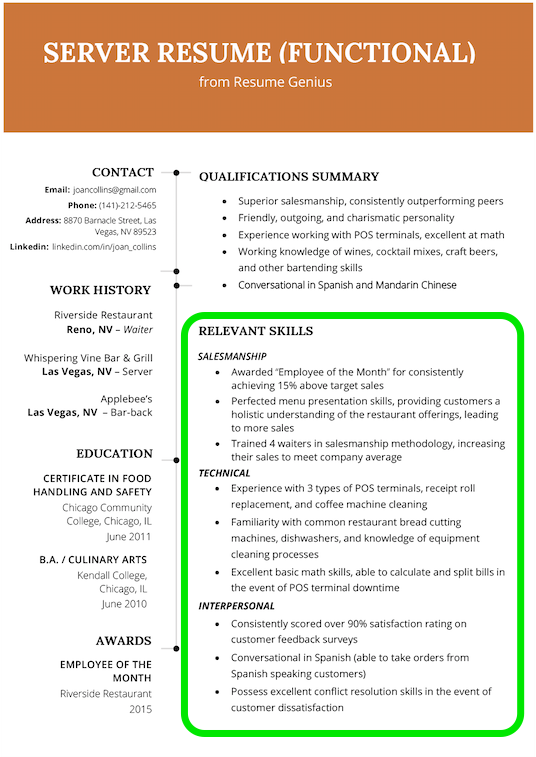
Server Resume
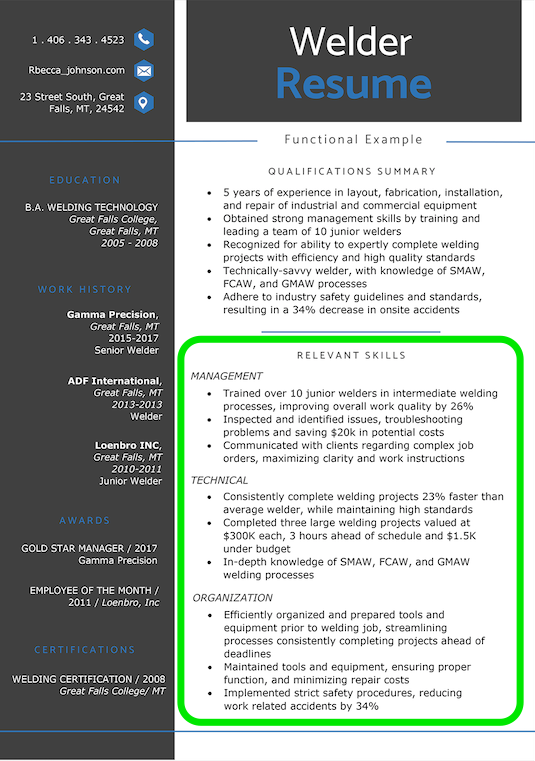
Welder Resume
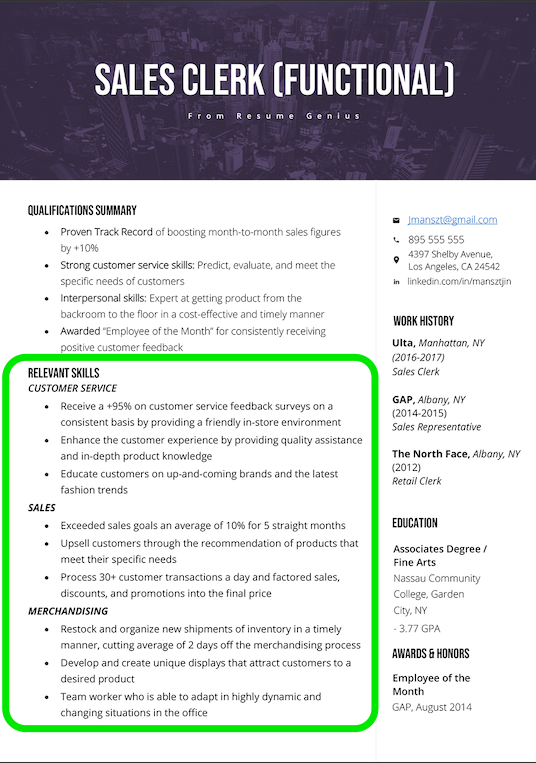
Sales Clerk Resume
Best for:
- Job seekers switching industries
- Workers with gaps in their work history
- Applicants with skills they want to detail in depth
Types of skills to list on your resume
Still unsure how to fill out the skills section of your resume? Consider using a combination of these types of skills:
Transferable skills
While some skills are specific to certain industries, many are transferable across industries. Transferable skills are especially relevant on career change resumes because you might not have many skills related to your new field.
Use a career change cover letter to explain why you’re changing industries and reassure the hiring manager you’re prepared for the switch.
Transferable hard skills
Many people want to know how to list Microsoft skills on their resume because many companies have made using Microsoft Office Suite a fundamental part of their employees’ daily routine.
In addition to adding the various Microsoft skills you’ve mastered to your resume, you should consider listing some of these other key transferable hard skills:
- Language fluency
- Computer skills (G Suite, Microsoft Office 365, HTML, cloud management)
- Writing (technical writing, copywriting, blogging)
- Spreadsheets (Excel, Google Sheets)
- Marketing (search engine optimization, Google AdWords, Google Analytics)
Transferable soft skills
Most soft skills are transferable, so you should try to develop these skills during your time at every company.
Time management, communication, people skills — all of these skills and more can be honed and developed in any job, and can be conveyed on a resume and in interviews.
Some key transferable soft skills include:
- Leadership skills (conflict resolution, delegation, problem solving)
- Organizational skills (goal setting, dependability, scheduling)
- Management skills (forecasting, public speaking, mentoring)
Industry-specific skills
Depending on the field you’re applying to, you need to add industry-specific skills to your resume.
Most industry-specific skills are hard skills, but certain jobs require even more well-developed soft skills than others.
For example, an undertaker will need perfect interpersonal skills, and the CEO of a company will need to have better leadership skills than 99% of people.
Here are some resources if you’re seeking skills for specific industries:
Frequently asked questions about resume skills sections
If you still have unanswered questions about listing skills on your resume, check out these commonly asked questions:
How do you categorize skills on a resume?
Here’s how you categorize skills on a resume:
List your hard skills first. You can categorize these skills under the heading “hard skills.” Hard skills are the skills or certifications necessary to do the job. For example, you need a driver’s license to be a taxi driver.
List your soft skills next. You can categorize these skills under the heading “soft skills” or “additional skills.” Soft skills are linked to your personality. For example, if you’re outgoing, you likely have great interpersonal skills. Employers want to hire people with strong soft skills because they work better within a team.
How can I describe my skills on my resume?
Describe your skills on your resume by focusing on your accomplishments and using action-oriented language.
Instead of just listing skills, provide specific examples of how you’ve applied those skills to achieve results in the professional experience section of your resume. Use your bullet points to describe achievements and connect them to relevant skills, and quantify achievements by using metrics to demonstrate the impact of your skills.
What should not be listed in a resume skills section?
Things that shouldn’t be listed in your resume skills section are irrelevant or overly generic skills.
Skills that aren’t related to the job you’re applying for clutter your resume and dilute its focus. Additionally, omit skills that are too basic or assumed for the role. For example, basic computer skills or proficiency in Microsoft Office are assumed for a lot of jobs and probably don’t need to be listed unless specifically mentioned in the job ad.
Prioritize skills that directly align with the job description to demonstrate that you’re a perfect match for the role.
Click to rate this article
4.3 Average rating


